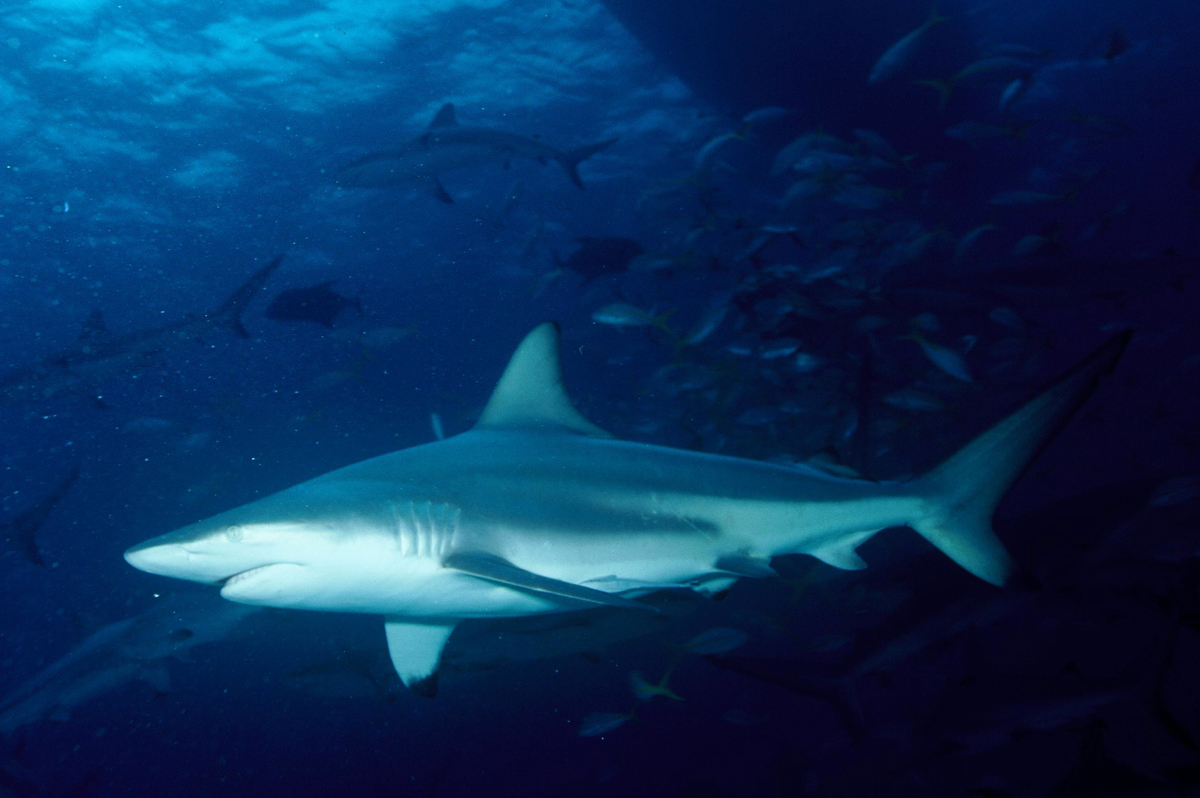Common Blacktip Shark, Carcharhinus limbatus (Müller & Henle 1839)
Other Names: Blacktip Shark, Blacktip Whaler

A Common Blacktip Shark, Carcharhinus limbatus, at Walkers Cay, Bahamas. Source: Albert Kok / Wikimedia Commons. License: Public Domain
Summary:
A dark-grey, bluish-grey or dusky-bronze shark with a white to yellowish-white belly, a dark band along each side to above the pelvic-fin origin, a distinct persistent black spot on the pelvic-fin tips, and black or dusky tips on the dorsal, pectoral, anal and lower lobe of caudal fins that fades with growth.
Cite this page as:
Bray, D.J. 2022, Carcharhinus limbatus in Fishes of Australia, accessed 20 May 2024, https://fishesofaustralia.net.au/home/species/1949
Common Blacktip Shark, Carcharhinus limbatus (Müller & Henle 1839)
More Info
|
Distribution |
Recorded in Australia from Cape Leeuwin, WA, to Bermagui, NSW. Elsewhere, the species is widespread in warm-temperate, subtropical and tropical waters worldwide. Inhabits inshore waters off beaches, in bays, estuaries, over coral reefs and off river mouths; with with inshore pupping and nursery grounds. |
|
Feeding |
Feeds mostly on pelagic and benthic fishes, and also preys on small sharks and rays, cephalopods and crustaceans. |
|
Fisheries |
Frequently taken in commercial and recreational fisheries. The flesh is well-regarded and the fins are highly marketable. |
|
Conservation |
Common blacktip sharks inhabit inshore waters, making them highly vulnerable to capture in commercial and recreational fisheries. |
|
Species Citation |
Carcharias (Prionodon) limbatus Müller & Henle, 1839, Systematische Beschreibung der Plagiostomen: 49, pl. 19. Type locality: Martinique Island, West Indies. |
|
Author |
Bray, D.J. 2022 |
Common Blacktip Shark, Carcharhinus limbatus (Müller & Henle 1839)
References
Allen, G.R. & Erdmann, M.V. 2012. Reef fishes of the East Indies. Perth : Tropical Reef Research 3 vols, 1260 pp.
Blaber, S.J.M., Brewer, D.T. & Harris, A.N. 1994. Distribution, biomass and community structure of demersal fishes of the Gulf of Carpentaria, Australia. Australian Journal of Marine and Freshwater Research 45(3): 375-396.
Blaber, S.J.M., Young, J.W. & Dunning, M.C. 1985. Community structure and zoogeographic affinities of the coastal fishes of the Dampier region of north-western Australia. Australian Journal of Marine and Freshwater Research 36: 247-266.
Burgess, H. G. & Branstetter, S. 2009. Carcharhinus limbatus. The IUCN Red List of Threatened Species. Version 2014.2.
Compagno, L.J.V., Dando, M. & Fowler, S. 2005. A Field Guide to the Sharks of the World. London : Collins 368 pp.
Compagno, L.J.V. & Niem, V.H. 1998. Family Carcharhinidae. pp. 1312-1360 in Carpenter, K.E. & Niem, V.H. (eds). The Living Marine Resources of the Western Central Pacific. FAO Species Identification Guide for Fisheries Purposes. Rome : FAO Vol. 2 687-1396 pp.
Grant, E.M. 2002. Guide to Fishes. Redcliffe : EM Grant Pty Ltd 880 pp.
Heupel MR, Simpfendorfer CA (2005) Quantitative analysis of aggregation behavior in juvenile blacktip sharks. Marine Biology 147: 1239–1249. Abstract
Heupel MR, Simpfendorfer CA, Hueter RE (2004) Estimation of shark home ranges using passive monitoring techniques. Environ Biol Fish 71: 135–142.
Last, P.R. & Stevens, J.D. 2009. Sharks and Rays of Australia. Collingwood : CSIRO Publishing Australia 2, 550 pp.
Macbeth, W.G., Vandenberg, M. & Graham, K.J. 2008. Identifying Sharks and Rays; A guide to Commercial Fishers. Sydney : New South Wales Department of Primary Industry 71 pp.
Müller, J. & Henle, F.G.J. 1839. Systematische Beschreibung der Plagiostomen. Berlin : Veit & Co pp. 29-102 pls.
Randall, J.E., Allen, G.R. & Steene, R. 1990. Fishes of the Great Barrier Reef and Coral Sea. Bathurst : Crawford House Press 507 pp. figs.
Randall, J.E., Allen, G.R. & Steene, R. 1997. Fishes of the Great Barrier Reef and Coral Sea. Bathurst : Crawford House Press 557 pp. figs.








